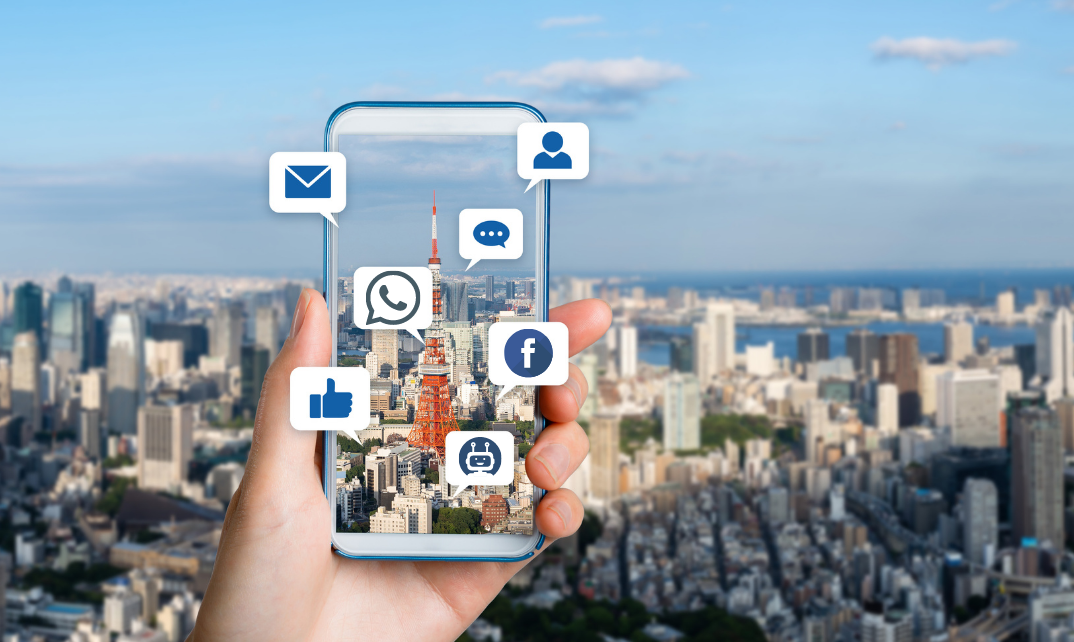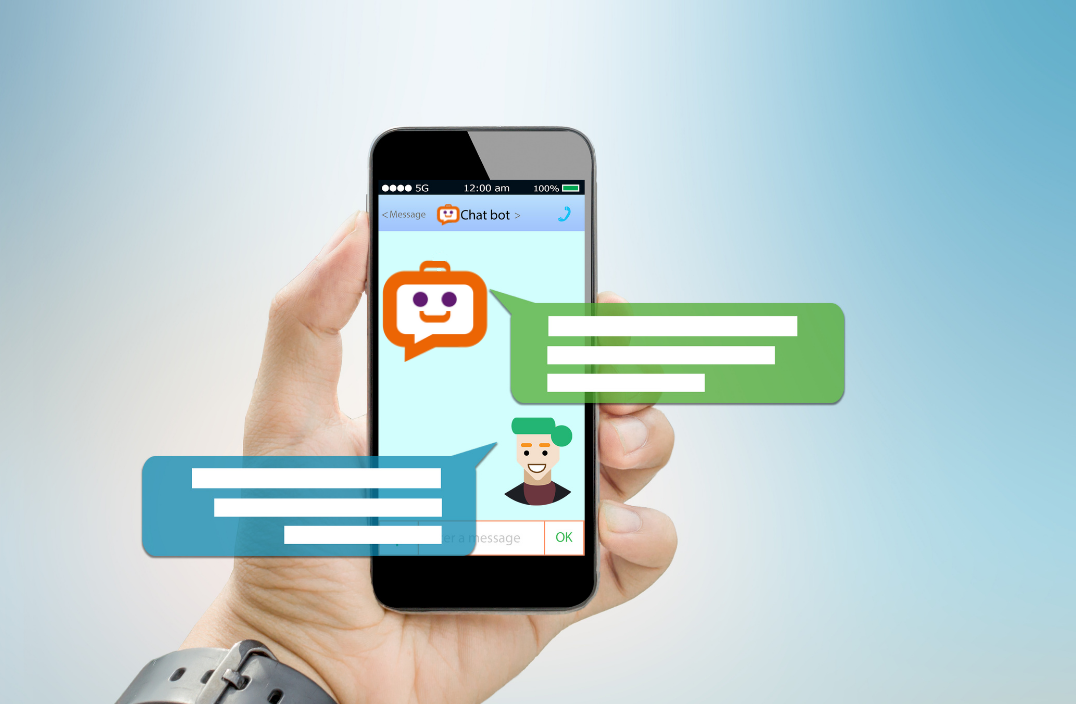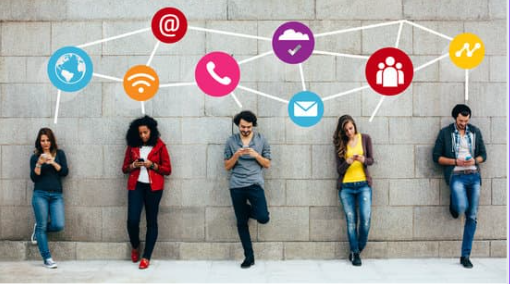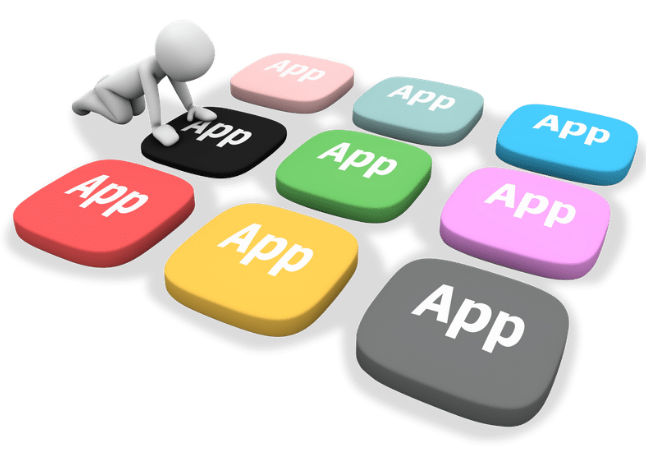
-
-
- AI Chatbot and Website
- AI Chatbots vs Messaging Apps (WhatsApp, Telegram, Viber)
- AI Chatbot vs and with Live Chat
- AI Chatbot vs Facebook Messenger
- AI Chatbot vs Phone Calls
- AI Chatbot vs Email
- AI Chatbots vs Mobile Apps
- AI Chatbots vs SMS
- AI Chatbots vs Website FAQ Sections and Forms
- AI Chatbots vs Contact Centers
Chatbots have been around for a while – since 1966, but they are becoming more and more popular in the digital world in the past 6-7 years. There are many reasons why chatbots are so popular among businesses and customers today. One of the most important reasons is that chatbots can provide in one or another way a better customer experience than any other type of communication tool.
As a matter of fact, the chatbot with conversational AI market was valued at $6.8 billion in 2021 and is estimated to grow to $18.4 billion by 2026 according to Markets and Markets. Moreover, the whole artificial intelligence market size (in which AI chatbots are included) to grow from USD 86.9 billion in 2022 to USD 407.0 billion by 2027, at a Compound Annual Growth Rate (CAGR) of 36.2% during the forecast period. In 2022, 9 out of 10 respondents agreed that conversational solutions are valuable for creating an all-around better experience for both customers and businesses, according to 2022 State of Conversations Report by Drift. Businesses already realized what is the importance of AI chatbots and will implement them as part of their services regardless of the industry and the other alternatives they use. They even can replace with chatbots some of the technologies or ways of communication they use now because of the multiple benefits chatbots bring to the business, customers, and employees. Chatbots can have some challenges as well, but those can be solved, and the advantages are way more.
Comparing Chatbots vs. Communication Alternatives & Why it Matters
There are many alternatives to chatbots, but none of them can provide the same benefits as a chatbot does. Chatbots can have a conversational AI module that allows them to learn from each interaction they have with a user and improve their performance over time. There is no denying that chatbots also could have their weaknesses depending on the implementation case, but this software solution comes with many benefits. Chatbots offer a more personalized experience to customers and are also more cost-effective and scalable than other alternatives.
In-person alternatives to chatbots include live chat widgets, email, phone, and messaging apps, social media communication, contact centers (in-house or outsourced), reception desks, and others. These are all solutions that involve actively the employees in the communication process.
Automated/digital alternative solutions are IVR, mobile apps, website FAQ sections, and other automated solutions providing self-service options to the customers. All of them have some advantages and disadvantages to consider before choosing the best one for your business, or a combination of a few of them.
Why does it matter to compare chatbots to other alternatives? When a business must choose which solution to use to provide better customer service and experience, save costs and time, optimize business operations and employees’ performance, and meet the need for an online presence, it must know all the pros and cons to choose the most suitable one. Some of the solutions can fit one business but others don’t because of the industry specifics, so knowing the benefits will help to choose the best one.
In general, these alternatives have the following negative sides that are improved or solved by chatbot backed up by conversational AI module:
- slow to use (customers waiting time),
- hard to navigate (bad user experience),
- more expensive (fixed cost for manpower, staff turnover, and training),
- harder to use (learning curve, download, and installation),
- psychological or emotional challenges (introverts prefer self-service options to face-to-face communication),
- limited usage (within hours of operations, by access, requires download or other),
therefore, in general, also do not allow first and zero data collection, structuring, and analysis without additional investments to the solution.
1. AI Chatbot and Website
 People ask why to have a chatbot when I have a website… That’s a very wrong concept! An AI chatbot on your site upgrades it and does what the website cannot – a 2-way communication but not with a human via live chat, but with conversational AI. The chatbot can have unlimited content personalized to the questions of the users for instant support. The website with a chatbot works together in favor of the business, its customers, partners, and employees. According to a report from April this year, 2022 Digital Experience Benchmark by Contentsquare, up to 65% of users leave a business website after viewing only one page. If they do not find what they are looking for quickly and easily, they most likely will continue their search on another site. That is not your goal, right? Also, according to the same report, 54% of website visitors scroll down only to half of a webpage and then leave it. Moreover, 80.95% of people answered on the question of how they communicate with brands that they prefer to do it on their websites, according to GoodFirms’s Chatbot Usage Survey’19 (during and after the pandemic the numbers are higher and continue to grow) and if a chatbot is waiting there to answer all of their questions immediately, these brands will not lose any new opportunity for sale or a conversion. Also, 8/10 people will use a chatbot if a brand can give the right user experience: Generation Z (18-24) – 92.31%, Millennials (25-39) – 83.78%, and Generation X (40-59) – 94.44%. The right user experience could be given for sure with the use of an AI chatbot on your site to assist 24/7/365/forever.
People ask why to have a chatbot when I have a website… That’s a very wrong concept! An AI chatbot on your site upgrades it and does what the website cannot – a 2-way communication but not with a human via live chat, but with conversational AI. The chatbot can have unlimited content personalized to the questions of the users for instant support. The website with a chatbot works together in favor of the business, its customers, partners, and employees. According to a report from April this year, 2022 Digital Experience Benchmark by Contentsquare, up to 65% of users leave a business website after viewing only one page. If they do not find what they are looking for quickly and easily, they most likely will continue their search on another site. That is not your goal, right? Also, according to the same report, 54% of website visitors scroll down only to half of a webpage and then leave it. Moreover, 80.95% of people answered on the question of how they communicate with brands that they prefer to do it on their websites, according to GoodFirms’s Chatbot Usage Survey’19 (during and after the pandemic the numbers are higher and continue to grow) and if a chatbot is waiting there to answer all of their questions immediately, these brands will not lose any new opportunity for sale or a conversion. Also, 8/10 people will use a chatbot if a brand can give the right user experience: Generation Z (18-24) – 92.31%, Millennials (25-39) – 83.78%, and Generation X (40-59) – 94.44%. The right user experience could be given for sure with the use of an AI chatbot on your site to assist 24/7/365/forever.The added value of a chatbot is to collect first- and zero-party data on customer behavior in the soon-to-become cookieless digital world, where after the pandemic 1 in every 3 customers chat with businesses outside of business hours (35% to 45% to be exact). Do you know if your customers got what they were looking for? What Google Analytics says about your website bounce rate? The solution is an AI chatbot on your site which will help with selling, engaging content, assisting 24/7/365, and collecting first and zero-party customer data. It is good for a business from any industry and size, also fast and easy to create, and also more affordable than ever now. Check all the benefits that an AI chatbot gives to your website (the digital center of your business) and why you should have both to further grow.
2. AI Chatbots vs Messaging Apps
 People are already using many messaging applications to chat with their family and friends, as well as for business, and sometimes it is easy to get confused about which one is best for them. When it comes to business communication with the customers, the company needs to choose one that fits best the company’s main goals and needs.
People are already using many messaging applications to chat with their family and friends, as well as for business, and sometimes it is easy to get confused about which one is best for them. When it comes to business communication with the customers, the company needs to choose one that fits best the company’s main goals and needs.Website AI chatbot vs WhatsApp chatbot
WhatsApp is a highly accessible app that many users have and businesses that chose this channel to communicate with their clients. Chatting with customers over Whatsapp bring us to the same issues as with other messengers: high cost, lack of instant assistance, difficulties to provide 24/7 service, customers waiting for a response, and other. To overcome these issues, many companies also use a WhatsApp chatbot. However, website chatbots surpass them because of some WhatsApp chatbots’ flaws:
- WhatsApp chatbots have limited elements – they only support text, images, and videos, while website AI chatbots support these and also cards with buttons, carousels, and forms to engage customers more and in different ways
- WhatsApp chatbots need more investment – businesses need licenses for integrations and if it is planned to send messages to users after 24 hours the business will need templated messages. For these templated messages WhatsApp will charge an additional fee. On the other hand, a website AI chatbot works 24/7, it has only monthly or annual subscription plans and has no additional fees according to the number of messages.
The business must consider all pros and cons when deciding which provider to choose, but when it comes to easy to use (no technical knowledge and skills), affordable (your CFO is smiling) and no integrations (your team is happy) needed to have a website chatbot, the Umni platform is the one to choose.
Website AI chatbot vs Telegram
Telegram is one of the most secure messaging platforms out there, thanks to its end-to-end encryption but it is not as used as other messaging platforms like Facebook Messenger and WhatsApp. Businesses started using it as a customer communications channel, using a Telegram chatbot as well.
This channel has similar challenges as WhatsApp and WhatsApp chatbots. Website AI chatbots are much easier to create and use with a friendly interface and more options for design creation with colors, name, logo and etc., while the Telegram bots depend only on the app requirements, and it is required to send commands to change anything that not everyone will remember to use or get the how-to.
Website AI chatbot vs Viber chatbot
Viber’s statistics on customer behavior in Bulgaria show that in 2021 the number of messages for order confirmations, delivery tracking, reminders for meetings, and others, increased by 52%, marketing messages for offers, discounts, and others increased by 91%, and calls for customer support increased by a surprising 237%! A chatbot with conversational AI can perfectly handle all these tasks and be located on the business website instead of dividing the channels where customers can communicate with the business. The website is the center of the digital ecosystem of a company and the place where the products and services are with an option to buy and an AI chatbot there is much more engaging rather than directing customers to another messaging app. Also, Viber is not so popular globally and if you are dealing with customers from many countries you will have to convince them to download the app to chat with you. The AI chatbot on the other hand is located on the business site and customers won’t need to download and install anything to chat with the business. Viber bots have their advantages as well but be smart where you want your customers to be – on your site or anywhere else.
At the end of the day, the business can use all existing communication channels to automatically direct the traffic and the communication to the website and its smart chatbot, educating its customers that this is the best place for them to be and be assisted properly.
3. AI Chatbot vs and with Live Chat
 Many companies ask themselves which of both is best – human assistance or chatbot with conversational AI. Both have pros and cons and can perform together for greater results. Customers want a wonderful experience when it comes to customer service and support, and AI chatbot along with live chat can perform together to level it up.
Many companies ask themselves which of both is best – human assistance or chatbot with conversational AI. Both have pros and cons and can perform together for greater results. Customers want a wonderful experience when it comes to customer service and support, and AI chatbot along with live chat can perform together to level it up.AI chatbots have some benefits over human interaction:
- Instant response – Customers want quick replies when it comes to talking with businesses
- No holidays – Chatbots do not go on holidays, have no breaks, and coffee pauses
- Lower costs – Chatbots cost a fraction of the salary of a customer service employee
- 24/7 support – They are always available and always on demand
- Consistency in learning – Everyday learning from customers’ behavior
- Consistency in company standards – Chatbots always provide content in the manner and standards of the business
- Talk in many languages when trained – Multilingual response option for every customer
- Multitasking – Chatbots can communicate with more than one customer at once
- Automatic customer first and zero party data collection – Every question and click is collected; there can be a form for every customer inquiry
 Although there are very impressive conversational AI models that can hold a human-like conversation in free dialog style, analyze user language to catch the user emotion and address it, and more, in general, compared to business AI chatbots, Live chat agents:
Although there are very impressive conversational AI models that can hold a human-like conversation in free dialog style, analyze user language to catch the user emotion and address it, and more, in general, compared to business AI chatbots, Live chat agents:- Are more compassionate than the chatbots – Agents are more flexible in their responses
- Have a more personal attitude – Live agents are more emotional and show more empathy
- Have more personal experience in their approach – More cognitive to handle customer emotions
- Perform more complex tasks than the chatbots which are best for more routine tasks
- Are more sensitive to culture and other human nature differences
When it comes to customer service and support, customers want their answers right now, no matter what time of the day it is. They want to receive what they are looking for at the exact moment of searching or otherwise they will look for an alternative. Therefore, if possible, AI chatbots and live chat agents should work together to meet all customer needs – the AI chatbot will help with the more routine ones while the agents will help when a more complex issue comes for solving. The AI chatbot will free up the time of the live chat agents with answering FAQs, solving daily tasks and the agents will have more time to grow their skills and help with the development of the company. For example, a customer wants information about company products and services, their prices, benefits, and more details about frequently asked questions – the AI chatbot can come to help 24/7 and instantly, but another customer has an issue with not receiving a package and this is when the live agent assistance is needed to see what the issue is and solve it while the AI chatbot helps the ones with the simpler tasks. As the AI chatbot never sleeps, when agents are resting, the AI chatbot can assist with everything that clients want, and they do not have to wait for an answer.
AI chatbot and live chat as solutions have their benefits and flaws but when it comes to solving customer problems and needs, both AI chatbots and human agents can perfectly help them together and work in favor of the business. Indeed, conversational AI for businesses is the new trend and the future of online communications, while live agents provide a more personal attitude. Chatbots with conversational AI can be trained by the business team – their way of communicating and tone of voice so people won’t make the difference between talking to a human or to a chatbot. In fact, according to HubSpot, 40% of consumers have no preference when it comes to engaging with a chatbot or a human for help, as long as they receive the support they need and the numbers will raise in the next years due to the chatbots further technological development, use cases and integrations with payments systems. According to the Drift 2022 State of Conversations Report, 40% of respondents expect a response within 5 seconds or less when using a chatbot and with live chat, the majority of respondents expect a response in 5 minutes or less. We are sure you know which solution is faster and which of both a customer would appreciate more when it comes to receiving an answer to his/her questions.
An AI chatbot cannot replace the human touch entirely when it comes to customer service and support. However, chatbots can be used to improve the customer service experience by providing quick and easy answers to common questions, freeing up live agents to handle more complex issues, and providing information support to the live chat agents. When used in combination, chatbots and customer service representatives can provide an outstanding level of customer service that is efficient, personal, and human.
4. AI Chatbot vs Facebook Messenger
 Facebook Messenger is used by more than one billion people and businesses. According to Facebook’s latest available information indicates there are businesses using Messenger, and they are exchanging 20 billion messages per month with their customers. Facebook messenger like other messengers is easy to use communication tool, however, it demands employees’ time to watch up for customers’ messages and to follow up on them with responses therefore expensive to maintain, it is almost impossible to have it available for customer service and support instantly and 24/7. Customers usually have to wait for an answer that they want right away. Automation of this communication channel was the next logical step, so the Facebook Messenger chatbots were introduced.
Facebook Messenger is used by more than one billion people and businesses. According to Facebook’s latest available information indicates there are businesses using Messenger, and they are exchanging 20 billion messages per month with their customers. Facebook messenger like other messengers is easy to use communication tool, however, it demands employees’ time to watch up for customers’ messages and to follow up on them with responses therefore expensive to maintain, it is almost impossible to have it available for customer service and support instantly and 24/7. Customers usually have to wait for an answer that they want right away. Automation of this communication channel was the next logical step, so the Facebook Messenger chatbots were introduced.In 2019, Facebook reported having 300,000 active chatbots in Messenger. In the last few years, many platforms started offering a tool to businesses to create a Facebook Messenger bot. Everything looked good, businesses used this way to communicate with customers and it was a way easier to do it as the majority of the customers would have a Facebook profile. Things have changed. Now Facebook Messenger has so many policies and made so many changes in the past couple of years that businesses and marketing specialists struggled to quickly adapt their marketing and communication strategies and the chatbots themselves to all new and changing policies and technical requirements. For example, in the early days of the chatbots in Messenger businesses were able to send as many messages as they wanted at the time they wanted to their chatbot subscribers – no restrictions. Businesses now can initiate a free message to a customer through a chatbot in Messenger only within 24 hours from the last communication with the user. Most companies were using Facebook Messenger chatbots mostly for marketing purposes and suddenly they became less useful, and their popularity began dropping.
The other option is to send the communication flow from Facebook Messenger and other messengers to the website and create a website chatbot. The businesses already have control over their websites and can drive more traffic and engagement to them by a chatbot – both the business and its customers will win. The business will increase the website traffic and session durations and customers won’t need to check different accounts to contact the business because all information will be at one place and the AI chatbot will be always available to assist.
A company can also use a basic Facebook Messenger chatbot whose only mission is to direct the customers automatically to the answers in the AI chatbot on the website to automate the communication in Messenger but use all the benefits of the AI chatbot on the website fully controlled by the business. This is what hotel complex “Izgreva” did to make sure with limited employees customers’ questions and inquiries are not overlooked – more here. There are platforms like Umni that provide businesses with the possibility to create, train and maintain their own chatbot without technical knowledge and skills and not depend on messengers for their website communication. You can get a 14-day free trial period to have a look at how the platform and the chatbot making work and decide to have such chatbot with or without AI.
5. AI Chatbot vs Phone Calls
 According to Meta, 64% of people say they would prefer to message a business than call it and these percentages are going to increase in the next few years because of the customers’ habits of online communication and digital self-service. Talking through the phone is turning into an old-fashioned way of communicating – the younger generations chat, and the older are following them. When a customer makes a phone call to the business, the staff does not always pick up or take the call with a delay. Often customers have to wait for a long time in queue, or for a call back for hours or even days, especially during the weekends and holidays. On the other hand, an AI chatbot is always available and customers will receive information right away around the clock when needed at any time of the day and week.
According to Meta, 64% of people say they would prefer to message a business than call it and these percentages are going to increase in the next few years because of the customers’ habits of online communication and digital self-service. Talking through the phone is turning into an old-fashioned way of communicating – the younger generations chat, and the older are following them. When a customer makes a phone call to the business, the staff does not always pick up or take the call with a delay. Often customers have to wait for a long time in queue, or for a call back for hours or even days, especially during the weekends and holidays. On the other hand, an AI chatbot is always available and customers will receive information right away around the clock when needed at any time of the day and week.Phone calls take too much time for both the business and the customers. According to IBM, 265 billion customer service calls are made and businesses spend, 80% of them can be served by AI chatbots without human involvement. On average 80% of these calls are frequently asked questions and routine inquiries, and they take 6 to 12 minutes of employee time per customer. The company employees lose time on this routine and get frequently distracted by the calls from their main responsibilities talking over basic stuff instead of actually dealing with more complex tasks. AI chatbot automates this not very efficient way of communication and provides a better customer experience.
6. AI Chatbot vs Email
 According to Juniper Research whitepaper – Why Chatbots Are Essential to Retail (2019), chatbots have a higher CTR (Click-Through-Rate) than emails, which means that users pay more attention to the information presented in a more interactive and engaging way by chatbots, especially with conversational AI, compared to the more traditional e-mail marketing.
According to Juniper Research whitepaper – Why Chatbots Are Essential to Retail (2019), chatbots have a higher CTR (Click-Through-Rate) than emails, which means that users pay more attention to the information presented in a more interactive and engaging way by chatbots, especially with conversational AI, compared to the more traditional e-mail marketing.As we mentioned in one of our previous blog posts, AI chatbots provide an immediate connection with customers while they’re searching for information or shopping. This is a big win for marketers: customers provide their data willingly while engaging with chatbots, and marketers are better able to target them with future offers according to their needs. When users actively engage with a chatbot, the business will learn what are the customers’ needs that actually care about the business services and products, and the customers will feel more understood by the business. AI chatbots surpass email marketing with the customer’s active and instant engagement while email communication comes with delay, not to mention the Spam or Promotions filters that prevent the business from reaching its clients or reaching them, but they never reply.
On the other hand, email marketing and AI chatbots can work together for a greater customer experience. Email is back on top with 26% of respondents reporting they have used it more than 10 times in the past six months, according to the 2022 State of Conversations Report by Drift while chatbot solutions were not used as frequently as email, but the majority of respondents said they have used them between 3-5 times in the past six months which suggests that, while traditional channels like email and phone calls are used for consistent communications, chatbot solutions provide users with a reliable place to start the conversation and assistance when an instant response is a must for the customer, or when the topic is routine. When businesses send emails to potential customers, they can place links to the chatbot with specific actions – a sign-up form, more information about a product or service, direct order, an answer to a question, a promotion, or else. The link can contain not only the specific detail that would open in the chatbot but also the specific page on which the chatbot will open. The chatbots will automatically gather data about customer behavior and sort all clicks and questions to help the business later analyze it. With this analysis, businesses can create email sequence automation with more personalized offers to satisfy customers with their actual needs. If you do not want to miss any opportunities, do not exclude any of the solutions – use both a chatbot and email marketing to grow your business.
7. AI Chatbots vs Mobile Apps
 Mobile applications need significant storage place on our phones and when it comes to downloading and installing another one, we mostly don’t, or do it to complete some activity and then uninstall it. Users globally usually organize their phones from Day 1 having it and think twice before downloading a new app – they already have the ones they need and use. Businesses that provide mobile apps have to keep in mind this obstacle and the fact that every mobile app comes with its learning curve – another challenge for users to overcome (why would they do it?). On the other hand, chatbots are mostly situated on the business’ website or on messaging platforms and users do not need to download and install anything new. All chatbots work the same: click, scroll, ask, and get the answer. When someone has used a chatbot once, he or she has no difficulties communicating afterward with another.
Mobile applications need significant storage place on our phones and when it comes to downloading and installing another one, we mostly don’t, or do it to complete some activity and then uninstall it. Users globally usually organize their phones from Day 1 having it and think twice before downloading a new app – they already have the ones they need and use. Businesses that provide mobile apps have to keep in mind this obstacle and the fact that every mobile app comes with its learning curve – another challenge for users to overcome (why would they do it?). On the other hand, chatbots are mostly situated on the business’ website or on messaging platforms and users do not need to download and install anything new. All chatbots work the same: click, scroll, ask, and get the answer. When someone has used a chatbot once, he or she has no difficulties communicating afterward with another.Advantages of the business mobile apps:
- The business provides its own tool that does not depend on third-party companies (the website chatbot is also such tool)
- It is made by the business choices and goals (the website chatbot also)
- It is maintained by the business itself or an outsourced company (the website chatbot is the same)
Disadvantages of the business mobile apps:
- Sometimes they are hard to navigate that leading to a bad user experience
- They are more expensive to be created and maintained (fixed cost for manpower, developers needed, many bugs can occur, and constant maintenance)
- They can be harder to use by customers (need learning, need download and installation and take much storage place)
- Take too much time for creation and testing
Advantages of AI chatbots over mobile apps:
- No need for download and installation
- Less expensive for creation, maintenance, testing, and training
- Easy to use tool both by the business (to create it) and by the customers
- It is also made by the business choices and goals
- Always available on the website to assist customers and drive traffic at the same time
- Businesses can direct customers to specific webpage and elements in the chatbot on it from anywhere online and offline with just 1 click on a link or scan of a QR code: perfect for sales, marketing, and customer support
8. AI Chatbots vs SMS
 SMS notifications are way more invading when it comes to notifying customers about business products and services. They have advantages as well – high open rates, high click rates, customers find out immediately about the information that is sent but they can forget easily about it because they receive it when they weren’t searching for this kind of information, and it is not interactive therefore memorable. In the meantime, chatbots are located on the business’ website or on a messaging platform where users willingly go to look for something they are interested in. Chatbots are helping the business to learn about customer behavior, what are their problems, and needs, while with SMS notifications companies only could know if the customer opened the message and clicked on the link or not. The trend of customers moving away from SMS and preferring to chat with the business through website online chat is not new. The first research and statistics that our team have seen were quoted online in 2016 with the stunning 80.7% of the users favoring website online chat to SMS communication with the business (only 19.3% of the users), assuming both services are free and possible (The 2016 Mobile Messaging Report by Ubisend).
SMS notifications are way more invading when it comes to notifying customers about business products and services. They have advantages as well – high open rates, high click rates, customers find out immediately about the information that is sent but they can forget easily about it because they receive it when they weren’t searching for this kind of information, and it is not interactive therefore memorable. In the meantime, chatbots are located on the business’ website or on a messaging platform where users willingly go to look for something they are interested in. Chatbots are helping the business to learn about customer behavior, what are their problems, and needs, while with SMS notifications companies only could know if the customer opened the message and clicked on the link or not. The trend of customers moving away from SMS and preferring to chat with the business through website online chat is not new. The first research and statistics that our team have seen were quoted online in 2016 with the stunning 80.7% of the users favoring website online chat to SMS communication with the business (only 19.3% of the users), assuming both services are free and possible (The 2016 Mobile Messaging Report by Ubisend).Imagine also a customer decides to answer back to the SMS – they may be charged for that while chatting with the chatbot won’t charge customers anything and they will receive information immediately when they asked for it. And one last thing, SMS notifications are mostly one-way communication channels while the AI chatbot is a 2-way communication channel that gathers more information than an SMS can have and offers way more options and interactive ways to customers for a better customer experience.
Here is one tip to keep in mind – you can use SMS to send notifications and direct customers to the chatbot on your website. This will help your business increase website traffic and customers will engage with the chatbot and it will help with their customer journey and experience. The shared link can be to a specific action in the AI chatbot – make a purchase, read something important, subscribe to a newsletter, and others. It’s a win-win strategy – so use it for your business to not miss any new opportunities and trends.
9. AI Chatbots vs Website FAQ Sections and Forms
 Website FAQ sections and forms offer limited information and capabilities that are usually one-size-fits-all and are not personalized to customer search and needs. FAQ sections can be replaced by an AI chatbot that will offer more than just an answer and drive customers through the designed within it marketing and sales funnels that are triggered by the customer question. Due to its technical specifics, the conversational AI chatbot can contain hundreds and thousands of customer questions and answers to them – something no website FAQ section could do.
Website FAQ sections and forms offer limited information and capabilities that are usually one-size-fits-all and are not personalized to customer search and needs. FAQ sections can be replaced by an AI chatbot that will offer more than just an answer and drive customers through the designed within it marketing and sales funnels that are triggered by the customer question. Due to its technical specifics, the conversational AI chatbot can contain hundreds and thousands of customer questions and answers to them – something no website FAQ section could do.Website forms can be replaced by forms in the AI chatbot on the website that can be personalized to a specific group of customers, attached to an answer to a specific question, and tied to a button in the specific information card. This way the AI chatbot is not only collecting the customers’ inquiries (zero party data) highly personalized but further is providing the company with feedback and with first-party data about the groups of customers that have used the specific forms.
AI chatbots provide many more options for sales and marketing purposes and answer customers instantly – any kind of questions that the business has trained it. With an AI chatbot on the website, you know what the customer questions and interests are when customers visit your website.
10. AI Chatbots vs Contact Centers
 Contact centers or the so-known call centers are used by companies of various sizes and industries – as their own internal, or as an outsourced call center that a company hires. Having such a service is associated with high cost – employee hiring and training to start with, even if outsourced. A chatbot with conversational AI can assist with FAQs and routine inquiries, therefore, lowering the need for such service and having it available for more complicated topics or issues. Chatbots help with lowering the time of handling customers’ inquiries and providing responses because they answer immediately and work 24/7. Yes, call center agents also work 24/7 but when it comes to live service there can be always a delay in answering for various reasons due to customers being put on hold in the queue, agents’ need to search for information, coffee breaks, employees being overloaded or distracted and other.
Contact centers or the so-known call centers are used by companies of various sizes and industries – as their own internal, or as an outsourced call center that a company hires. Having such a service is associated with high cost – employee hiring and training to start with, even if outsourced. A chatbot with conversational AI can assist with FAQs and routine inquiries, therefore, lowering the need for such service and having it available for more complicated topics or issues. Chatbots help with lowering the time of handling customers’ inquiries and providing responses because they answer immediately and work 24/7. Yes, call center agents also work 24/7 but when it comes to live service there can be always a delay in answering for various reasons due to customers being put on hold in the queue, agents’ need to search for information, coffee breaks, employees being overloaded or distracted and other.It is not necessary to look at the comparison from AI chatbots vs. Contact centers’ point of view. There is also an option for call center agents and AI chatbots to work together for the best results. Chatbots can help with routine tasks while agents handle complicated ones.
Is there a worry that the chatbots will still do the job? Not at all. As a matter of fact, according to a study by Aspect, quoted in 2017, customer service agents feel chatbots will indirectly lead to improving their value to the organization. When employees were asked about their work together with a chatbot, 59% felt more satisfied in their jobs and more committed to the company. 79% of the staff felt that handling more complex customer issues improves their skills. 72% shared that they felt relieved when assisted by a chatbot, they were having a bigger impact on the company. 64% of the staff said chatbots were enabling them to provide a more personalized service experience for customers. Today’s chatbots are helping customer service agents even more due to the inclusion of conversational AI and advancing of chatbot technology overall.
Which Solution is Best for You?
Different types of businesses have different needs and need diversified solutions. To choose the best solution for your business first you need to identify the specific goals you want to achieve to start planning the use of such technology. However, not always there is only one solution that will meet all business needs and a combination of several ones can help accomplish more than just choosing one. An AI chatbot with a combination of live chat for example is the perfect combination to handle customer inquiries and provide the best customer experience. In the past six months, 83% of support agents have used a self-service chatbot and 89% have used a live chat solution. Customers were far less likely to have used web forms, texts, or social media to contact customer support, according to the 2022 State of Conversations Report by Drift. The AI chatbot will help with the routine and more simple tasks and the live agents will deal with the issues that need a more personal attitude. All of that can occur on the business site which is the focal point of any business. Directing customers to it would not only save time to customers and improve their experience – they won’t need to go all over all online business accounts to find information or service. It would help the business optimize employees’ time and performance, save on cost and resources and increase the return on sales and marketing efforts. A win-win strategy to use to grow your business: more happy clients – more happy deals!

Source: 2022 State of Conversations Report by Drift
You can see on the image that customers expect immediate response and an AI chatbot gives it, unlike live chat agents and phone calls, so choose wisely which option is best for your business.

Source: 2022 State of Conversations Report by Drift
As you can see, in this comparison of the communication channels and when users expect their answers from them, the fastest answers are expected from a chatbot. That’s why you should keep in mind that a combination of communication channels would cover best the needs of your customers, but the speed of the response is critical for them. With every moment passing by, customers are less likely to wait for a response and the chance for them to move on for searching for other alternatives to your product and services increases.
A chatbot with other of its alternatives is the best option when they promote the chatbot to become the communication funnel starting point with focus and direction to the website and the AI chatbot on it – directing customers’ questions to one place to collect first and zero-party customer data and guide customers to where the business wants them to be. Offering a chatbot can turn out to be a boon for your businesses’ s brand image; people think of such brands to be tech-savvy (87.62%), customer-oriented (83.81%), and proactive (85.71%), according to the Usage & Statistics for an Engaging Online Chatbot Design: GoodFirms Research. The Umni platform provides such an opportunity – to create and place an AI chatbot on your business site with the necessary functionalities to help your team to grow the business further and step ahead of your competitors. Feel free to contact us for a demo and consulting for an informed decision for your business.
-